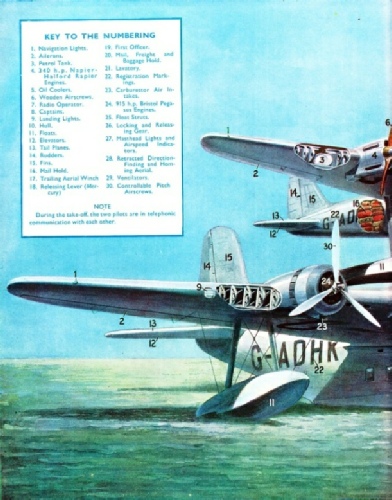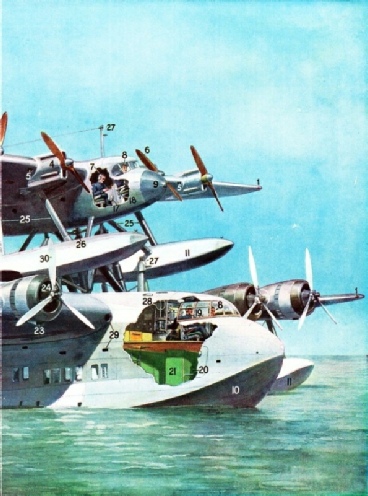
© Wonders of World Aviation 2015-


Part 1
Part 1 of Wonders of World Aviation was published on Tuesday 8th March 1938, price 7d.
It was a normal issue of 32, not 36 pages, unlike the other series. This part included a superb folding colour plate showing a cutaway drawing of the Short-Mayo Composite Aircraft which accompanied an article on the Short-Mayo Aircraft . There was also a central photogravure supplement illustrating the article on Parachute Landings. All these are illustrated below.
The Cover
The cover shows an unidentified aircraft propeller and engine.
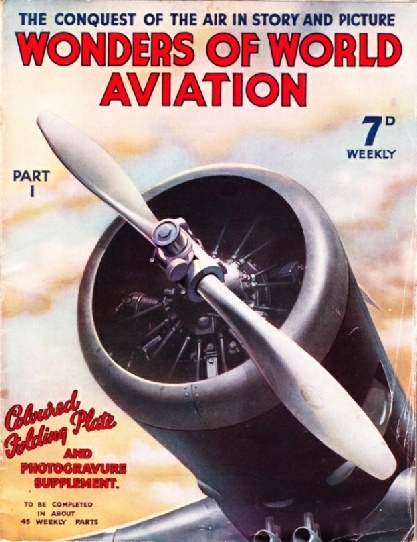
Contents of Part 1
Foreword
By the Editor
FLIGHT is, perhaps, man’s greatest audacity. The dream of it, born as soon as the human eye looked upward with aspiration, was audacious. The pioneers of balloons and heavier-than-air machines were gifted with enviable impertinence. The completion of the conquest, as far as the conquest of the air may be thought of as complete, has given birth to bolder and bolder enterprise.
Because of these things the present work is brought into being. It is an attempt to deal faithfully and sincerely with a vast and more than ordinarily interesting subject. It is an attempt to present without bias or favour a complete survey of aeronautical endeavour.
That the subject is a controversial one is common knowledge, but I have tried, I think successfully, to represent all the various schools of thought which are to be found in the world of aeronautics.
IN PLANNING these volumes, I have been mindful of the worldwide nature of the subject. Its scope, both in time and place; is extraordinarily broad, and the variety of its aspects too obvious to need any stressing here. Hence, much time and labour have been spent in collecting all the material essential to a work as comprehensive as Wonders of World Aviation.
That the effort will fulfil its purpose of satisfying and pleasing those who share an interest in this great and fascinating subject is a hope which I carry with some confidence. The sincerity of the effort at least cannot be questioned, and I venture to believe that the work itself will take an important place in the annals of aviation.
“Filling the World With Amazement”
The panorama of aeronautical achievement, which forms an introductory chapter to the series.
How an Aeroplane Flies
An outline of the principles governing modern aviation design. This chapter describes, with reference to diagrams and photographs, how an aeroplane flies.
Parachute Landings
How emergency equipment has increased safety in flying. The parachute is now the standard equipment for the flying personnel of the air forces of the British Commonwealth of Nations, the United States of America and other countries, and is in regular use by civilian aviators in many parts of the world.
Parachute Landings
Photogravure Supplement
HOW THE EARTH LOOKS to the parachutist after the canopy has opened. This remarkable photograph was taken with an automatic camera fixed inside the parachute. At one time it was thought that a man falling or diving from a great height was incapable of thought or action after he had fallen several hundred feet. This was disproved, however, by Leslie Irvin, an experienced high diver. He maintained that if a diver could control his body during a dive of less than 100 feet, it should be possible for a parachutist to control mind and muscle while jumping or diving from a height of several thousand feet. Irvin put his theories into practice in an experimental dive in 1919, when he became the first man to open a parachute while falling.
Parachute Landings: Photogravure Supplement
AFTER THE PARACHUTE HAS OPENED. The process of opening is so rapid that it is impossible to see it with the eye. It has been filmed with a slow-motion camera, and the film showed that the air in the upper part causes the canopy to open from the apex to the periphery. A parachute lands with the wind, and therefore the parachutist must face the wind so that he can watch his descent. If he is drifting backwards he turns the parachute. To do this he tugs the shrouds to pull down the edge of the canopy in the direction in which he wants to turn. He then grasps the shrouds on the opposite side and, without pulling down, gives the parachute a twist in the desired direction, turning it at the same time.
Parachute Landings:
Photogravure Supplement
PARACHUTE DRILL in the Russian Army. This photograph shows some 100 parachute jumpers in the air at the same time. Others who have landed have unbuckled their harnesses and folded the parachutes. In many parts of the USSR parachute jumping is a popular sport, and the public is provided with parachute towers for training purposes.
Moving Wing Flight
Ingenious solutions of the landing-speed problem.
This article is first in the series on Unorthodox Aircraft.
The Short-Mayo Aircraft
Launching a heavily loaded seaplane from the back of a flying boat. This chapter describes the Short-Mayo composite aircraft. The composite machine represents one of the forward steps in the work of the designer and constructor of today.
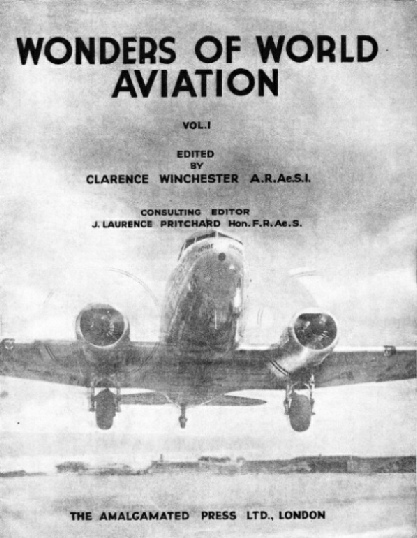
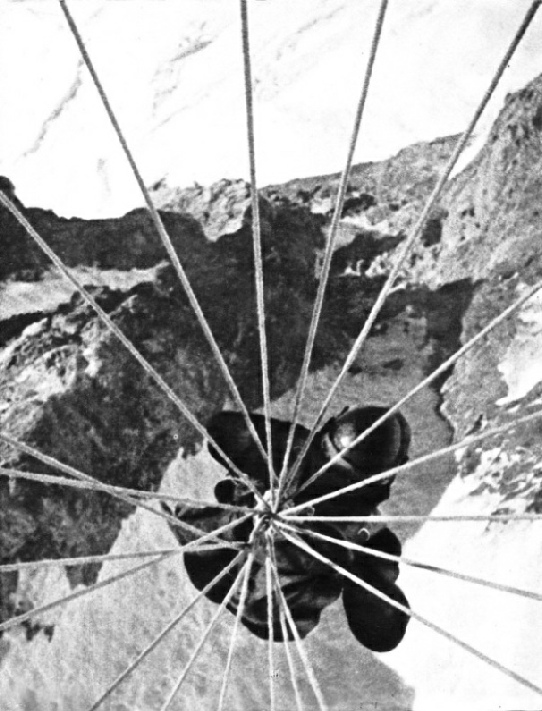
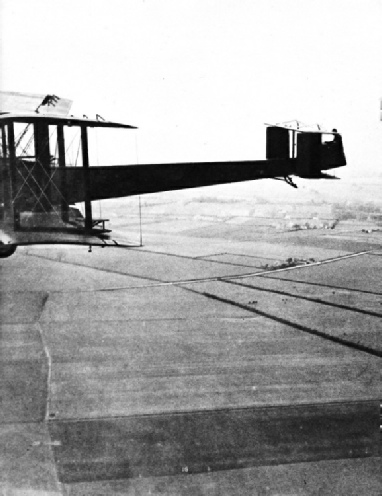
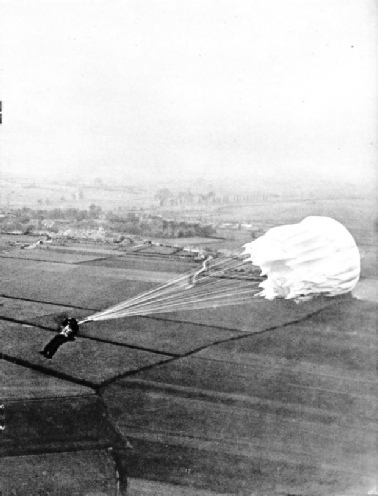
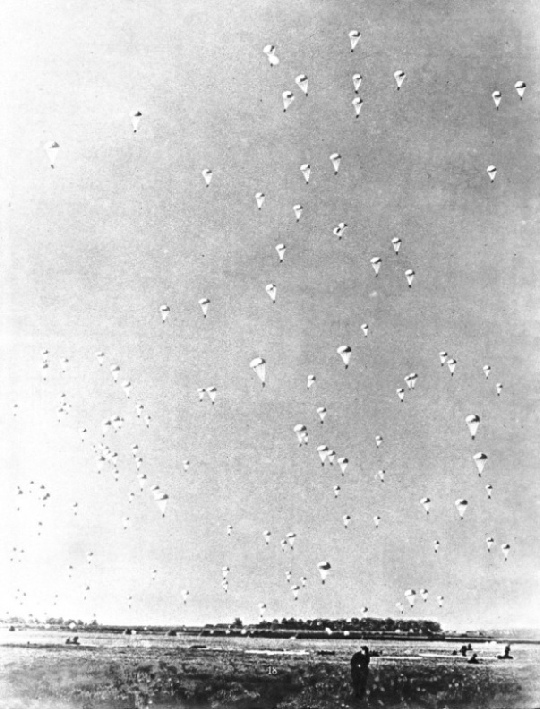
The Short-Mayo Composite Aircraft
The Short-Mayo composite aircraft. During the take-off, the two pilots are in telephonic communication with one another.
The key to the numbering is: 1. Navigation lights; 2. Ailerons; 3. Petrol tank; 4. 340 hp Napier-Halford Rapier engines; 5. Oil coolers; 6. Wooden airscrews; 7. Radio operator; 8. Captains; 9. Landing lights; 10. Hull; 11. Floats; 12. Elevators; 13. Tail planes; 14. Rudders; 15. Fins; 16. Mail hold; 17. Trailing aerial winch; 18. Releasing lever (Mercury); 19. First officer; 20. Mail, freight and baggage hold; 21. Lavatory; registration markings; 23. Carburettor air intakes; 24. 915 hp Bristol Pegasus engines; 25. Float struts; 26. Locking and releasing gear; 27. Masthead lights and airspeed indicators; 28. Retracted direction-finding and homing aerial; 29. Ventilators; 30. Controllable pitch airscrews.
Into the Stratosphere (Part 1)
The first ascent of over ten miles by Professor Auguste Piccard. This chapter is concluded in part 2.
